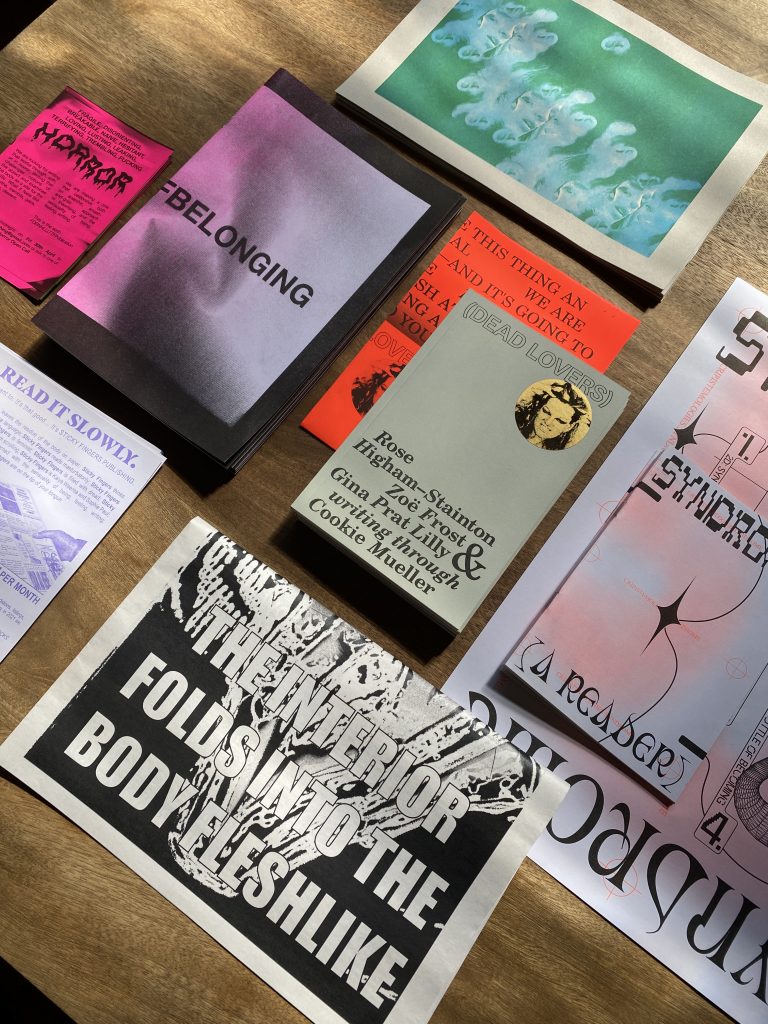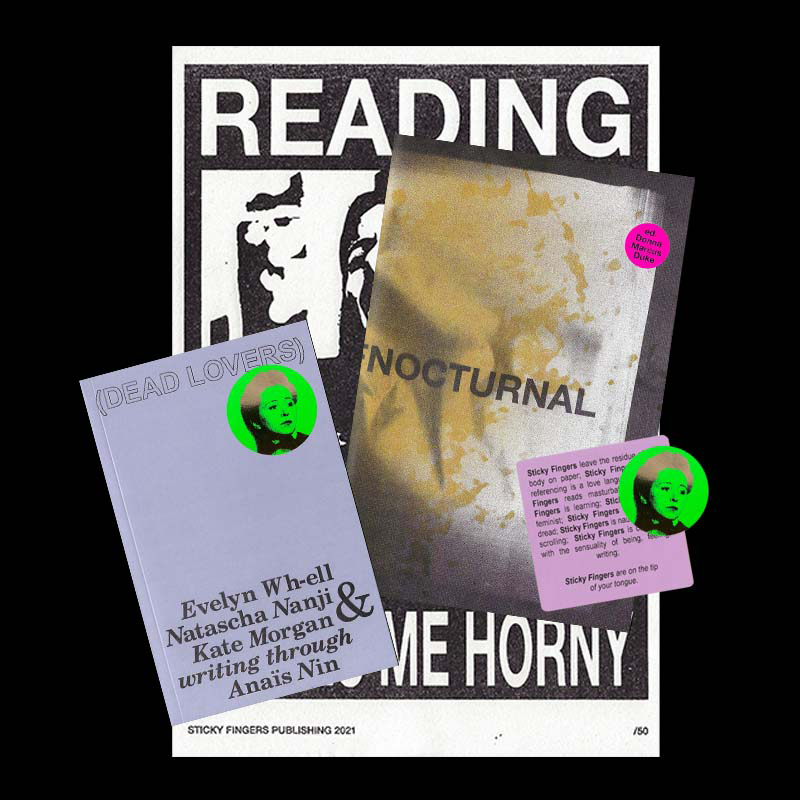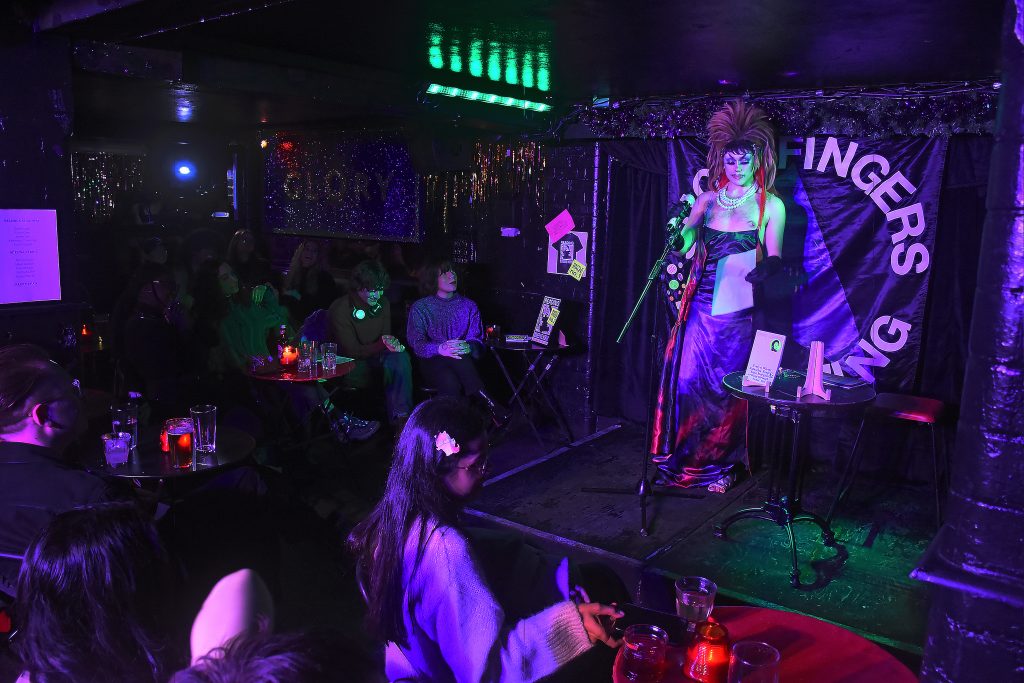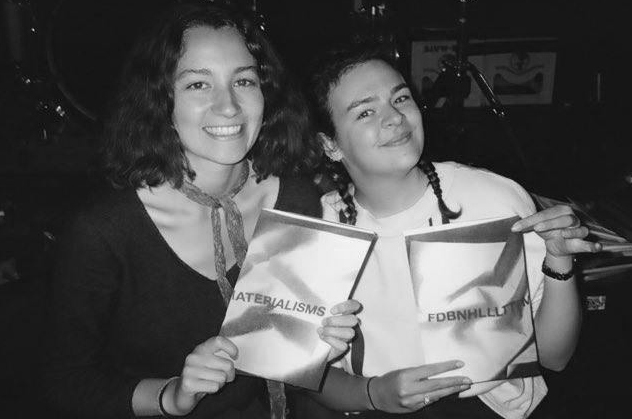STICKY FINGERS PUBLISHING
GENERAZIONE CRITICA: Sticky Fingers started with a collaboration between Sophie Paul and Kaiya Waerea. How did this happen?
STICKY FINGERS: The two of us first published together between our second and third year of our undergraduate studies. We had both written essays for our BA in response to a brief about Feminist New Materialisms – a rather dense but very seductive area of feminist theory. Through our thinking with FNM’s we came together with a shared concern for what knowledge feels like. We published our essays alongside a few other texts we gathered from friends, peers and our tutors, and sold them at our local zine fair at DIY Space for London. This was the first in what became our FDBN series – we had no plan to publish together again, but then we did, and again, and again.
GC: How did you choose Sticky Fingers Publishing as your name?
SF: When we started publishing together, we called ourselves FDBNHLLLTTF (fragile, disorienting, breakable, naive, hesitant, loving, lusting, leaking, trembling, terrifying, fucking) Publications, because FDBNHLLLTTFMATERIALISMS was the first thing we did together, and we didn’t really think much further beyond that. We thought it was funny to have such an obscenely long name that nobody (including ourselves) could ever remember, and enjoyed how this resisted the pressure to make ourselves sellable. We published a few more FDBN’S, and it was only really when we started our mailouts in 2020 that we decided to come up with a more legible name to make FDBN a kind of imprint of.
We went through loads of really silly options before settling on Sticky Fingers; we liked Sticky Fingers because it references bodily, abject, gross things, embodied ways of moving through theory, fiction and the world. There’s a quote from Kate Zambreno in her book ‘Heroines’ that we both love, about lubed fingers all over library books, and we often lean into speaking of this mastubatory mode of reading. Having ‘sticky fingers’ also means to steal, which is really interesting in reference to writers like Kathy Acker who practices plagiarism.

GC: You are based in London and in your publications there is a recurrent attention to punk culture, is this by chance or follows a specific editorial interest?
SF: This is an interesting observation. When we started thinking about what knowledge feels like, we were also interested in what we described as an “anarchic, smash-and-grab approach to theorizing.” This reflects an anti-institutional ethic of knowledge production, the belief that we can and should come as we are. We like working with text that feels like it’s taking a risk – our second FDBN publication, FDBNHLLLTTFFICTIONSasked for “writing that you are too scared to publish,” the challenge being to find comfort in taking a risk together.
This drive emerges from our feminisms, which are innately ‘punk’ in that they are disruptive of the common order. All of this comes together and is reflected in the aesthetic language we have developed, which is lead by a desire to minimize labor we aren’t interested in (ie. over-designed and strategized social media) and maximize the work that gives us pleasure; working deeply and collaboratively to find moments of collective empowerment within the publishing process.
GC: Dead Lovers is one of your publication series in which you commission three new texts by contemporary writers to think through, around or with the work of a dead writer. With this series you try to establish alternative genealogies with fresh and new experimentations; feminisms are intended not as a subject but more as a method. Could you explain better this approach that is both historical and contemporary? How can you put different authors in dialog?
SF: The questions around publishing new writing that works in, around, or through, works by deceased feminist writers is complicated because of the distance that sits between us and the original text. In this way, while these publications are about love, intimacy and presence, they are as much about absence and unknowing. Writing across this distance allows us to talk openly about modes of referencing and how we might establish lineages of practice; who we want to position ourselves next to; who we are in solidarity with.
When we talk about feminisms as method in regard to this series, we are referring to the how of these publications. Through group readings, group crits, and group editing sessions, the two of us along with our three writers come to each other as equals, to rearrange the hierarchies that have become normative within the publishing process. We prelude these sessions with discussions around editing boundaries and collective empowerment.
We always choose a text to focus on that we ‘love’ in some way, but love is complicated; writing about something from the past in the contemporary moment requires staying with this complexity. It allows us to look at writers whose work was historically overlooked because of their subjective positionality, gender, sexuality or class, what they chose to write about, and their refusal to do what was expected. This mode of paying attention is a kind of loving, and these are the avenues of thought that these publications are intended to contribute to.

GC: FDBNHLLLTTF (fragile, disorienting, breakable, naive, hesitant, loving, lusting, leaking, trembling, terrifying, fucking) Publications is another line of your publishing house; these publications are constructed with material that you receive through themed open calls. What is the common ground throughout this series? How do you build up the issue with a very wide range of material coming from various authors?
SF: The words which make up this acronym can be understood as an affective field which the FDBN series lives within. This list can work with the text in various ways; texts might act through one of a few of these terms, or borrow from it in terms of sensation, style for format, or speak to how the writing is in a constant process of becoming, unfurling, unfinished-ness. The theme of each individual issue is what these affects apply themselves to, and how the texts of each issue relate to one another.
In constructing each issue we try to get a balance of interpretation of the theme, of forms, of new and previously published writers, of marginal positionalities, and kinds of references and how they’re used. We have the restriction of how many pages we can fit under our guillotine, which is about 60.
GC: Going through your publications from the beginning of Sticky Fingers until nowadays, which is the publication that has given you more surprises and that somehow could also change your expectation or let you rethink your practice?
SF: Our monthly mailouts are the thing that still continues to surprise us. We started our mailouts out of necessity in the spring of 2020, when due to the first UK lockdown, we found ourselves unable to access the same spaces, printing facilities and modes of distribution that we previously relied on. We started to pull together whatever we could, printing on our home printers and posting them to around 20 subscribers monthly. The mailouts are a practice in producing something to a tight turnaround, and taking a risk with new and in-progress works. We’ve continued to do our mail outs since, and are up to our 22nd Mailout, with 50 subscribers! We now have a short list of regular contributors too, who write to us with poetry, letters, screenplay scripts, recipes and more. Our mailouts slightly less polished and a bit sillier than anything else we do, and we find it really rewarding and important to remind ourselves that everything starts somewhere.
GC: How important is the interface of the social network inside the direction of your publishing house? Could these channels of sources help you in growing your reality and in finding new interesting projects or artists?
SF: Before the first lockdown in the UK, we didn’t have any social media presence, and only circulated our open calls through posters and by email. Going online has widened and changed our reader and writership in unexpected and wonderful ways, and this continues to be the case.
In saying that, we are weary of how emerging practitioners of all kinds have to play the game which Instagram forces us to, and so try to minimize this work where possible. We meet in our studio every Monday and spend 10 minutes planning our posts for the week to try to manage this. We also try to share the work of writing image descriptions and general instagram-admin, and we both try not to get too wrapped up in our online-presence. We just really love print and have always made printed matter our priority.
GC: Coming back to the physical world, it is very interesting to focus on the Winter Party organized by Sticky Fingers. You launched the last two publications, FDBNHLLLTTFNOCTURNAL & DEAD LOVERS: ANAÏS NIN in December 2021 with a special evening in London. Donna The First, a white queer non binary drag queen was invited to present the event and introduce readings from the various authors that were involved in the publications. This reminds of the dadaist cabarets that were occurring in Zurich some decades ago where there was a strong intent to create a sense of community and an intense will to experiment. How important is it for Sticky Fingers to create a connection between the various authors and also between the authors and the public? Are you planning to organize more events following this line?
SF: Donna is a brilliant friend of ours, who also guest edited NOCTURNAL. They are very involved in queer nightlife, which is reflected in their theme choice and led us to the desire for puting on an evening to celebrate its publication.
Our readers tend to often also be our writers. We care about cultivating a scene because this is how culture happens. Reading, writing and publishing can be intimate, ecstatic, erotic if you let it. We see these codependent activities as part of how knowledge throbs.
After the joy of our first party, we are planning to try out doing them seasonally with Donna’s event organizing expertise. We tend to date things in terms of seasons, which you will notice in the masthead of any of our publications – an instinct to think cyclically instead of linearly.

GC: Sticky Fingers is a constant growing reality and it seems that it is opening to different experiments inside and outside the dimension of books and magazines. What are your future plans for the publishing house?
SF: We’ve got some very exciting things lined up for this year, including: MISS READ Art Book Fair in Berlin at the end of April; a monograph by Evelyn Wh-ell, which will be available at MISS READ; an open call for our next FDBNHLLLTTFPublication on the theme of PLAGIARISM; a pamphlet on Notes on Intra-dependant Publishing; an exhibition of at Lunchtime Gallery in Glasgow & more!
We have also recently launched our ‘Self-Publishing Sessions’: individual sessions to advise and assist people with their self-publishing endeavors, and are planning to run saturday print clubs, which would be really fun. We are constantly looking for opportunities to continue doing what we love and to make it sustainable financially. We’ve never planned too far ahead, and are fairly instinctive in terms of the kind of work we take on, which we think keeps our work exciting. We keep on working together because we enjoy publishing brilliant writing together and doing so in each other’s company, which is always enriching, gentle, and something we see a huge value in.
Copyrights ©METRONOM
03/02/2022

